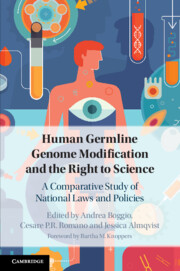 Human Germline Genome Modification and the Right to Science
Human Germline Genome Modification and the Right to Science Book contents
- Human Germline Genome Modification and the Right to Science
- Human Germline Genome Modification and the Right to Science
- Copyright page
- Dedication
- Contents
- Figures
- Tables
- Notes on Contributors
- Foreword
- Preface
- Acknowledgments
- Abbreviations
- 1 Introduction
- 2 The Governance of Human (Germline) Genome Modification at the International and Transnational Levels
- The Regulation of Genome Modification at the National Level
- Part I North America
- Part II Europe
- Part III Asia
- 16 The Regulation of Human Germline Genome Modification in Japan
- 17 The Regulation of Human Germline Genome Modification in the People’s Republic of China
- 18 The Regulation of Human Germline Genome Modification in the Republic of Korea
- 19 The Regulation of Human Germline Genome Modification in Singapore
- Part IV Other OECD Countries
- Part V Conclusions
- Index
16 - The Regulation of Human Germline Genome Modification in Japan
from Part III - Asia
Published online by Cambridge University Press: 15 November 2019
- Human Germline Genome Modification and the Right to Science
- Human Germline Genome Modification and the Right to Science
- Copyright page
- Dedication
- Contents
- Figures
- Tables
- Notes on Contributors
- Foreword
- Preface
- Acknowledgments
- Abbreviations
- 1 Introduction
- 2 The Governance of Human (Germline) Genome Modification at the International and Transnational Levels
- The Regulation of Genome Modification at the National Level
- Part I North America
- Part II Europe
- Part III Asia
- 16 The Regulation of Human Germline Genome Modification in Japan
- 17 The Regulation of Human Germline Genome Modification in the People’s Republic of China
- 18 The Regulation of Human Germline Genome Modification in the Republic of Korea
- 19 The Regulation of Human Germline Genome Modification in Singapore
- Part IV Other OECD Countries
- Part V Conclusions
- Index
Summary
Japan is a leader in life science, and is one of the countries in the world where reproductive medicine is actively practised. This chapter first analyses the overall regulatory framework for research using human germ cells and embryos (germline). Then, it discusses the specific regulations affecting research on human germline genome modification, while considering the clinical research of an egg mitochondrial DNA modifying technique, called AUGMENT. Regarding research involving human germline genome modification, the Japanese regulatory framework is characterized by gaps and inconsistencies. Moreover, it discusses some of the reasons why Japan lacks a key law governing the medical use of human germline, although the Act on Regulation of Human Cloning Techniques is put into force. It points out that a majority of Japanese is not affiliated with religion, and ‘Morals’ is a vague concept in Japanese. Finally, it discusses a possible regulatory reform, considering four provisions relevant to human rights in the Constitution of Japan.
- Type
- Chapter
- Information
- Human Germline Genome Modification and the Right to ScienceA Comparative Study of National Laws and Policies, pp. 441 - 468Publisher: Cambridge University PressPrint publication year: 2020
- 3
- Cited by
